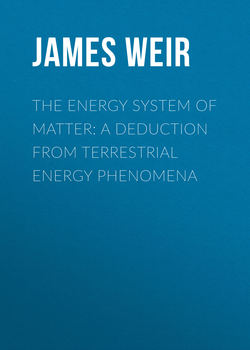Читать книгу The Energy System of Matter: A Deduction from Terrestrial Energy Phenomena - James Weir - Страница 10
PART I
GENERAL STATEMENT
8. Interactions of Two Planetary Bodies—Equilibrium Phenomena
ОглавлениеUp to the present point, the cosmical system has been assumed to be composed of one planetary body only in addition to the primary mass. It is clear, however, that by repetition of the process already described, the system could readily evolve more than one planet; it might, in fact, have several planetary masses originating in the same primary, each endowed with a definite modicum of energy, and each pursuing a persistent orbit round the central axis of the system. Since the mass of the primary decreases as each successive planet is cast off, its gravitative attractive powers will also decrease, and with every such decline in the central restraining force the orbits of the previously constituted planets will naturally widen. By the formation in this way of a series of planetary masses, the material of the original primary body would be as it were distributed over a larger area or space, and this separation would be accompanied by a corresponding decrease in the gravitative attraction between the several masses. If the distributive or disruptive process were carried to its limit by the continuous application of rotatory energy to each separate unit of the system, this limit would be dependent on the capacity of the system for energy. As is shown later (§ 20), this capacity would be determined by the mass of the system.
For simplicity, let us consider the case in which there are two planetary bodies only in the system in addition to the primary. In virtue of the gravitative attraction or gravitation field between the two, they will mutually attract one another in their motion, and each will, in consequence, be deflected more or less out of that orbital path which it would normally pursue in the absence of the other. This attraction will naturally be greatest when the planets are in the closest proximity; the planet having the widest orbit will then be drawn inwards towards the central axis, the other will be drawn outwards. The distance moved in this way by each will depend on its mass, and on the forces brought to bear on it by the combined action of the two remaining masses of the system. Moving thus in different directions, the motion of each planet is carried out in the lines of the gravitation field between the two. One planet, therefore, gains and the other loses energy of position with respect to the central axis of the system. The one planet can thus influence, to some extent, the energy properties of the other, although there is absolutely no direct energy communication between the two; as shown hereafter, the whole action and the energy change will be due simply to the motion carried out in the field of the incepting gravitation influence.
It is clear, however, that this influence is exerted on the distribution of the energy, on the form in which it is manifested, and in no way affects the energy totality of either planet. Each, as before, remains a separate system with conservative energy properties. That planet which loses energy of position gains energy of motion, and is correspondingly accelerated in its orbital path; the other, in gaining energy of position, does so at the expense of its own energy of motion, and is retarded accordingly. The action is really very simple in nature when viewed from a purely energy standpoint. It has been dealt with in some detail in order to emphasise the fact that there is absolutely nothing in the nature of a transmission of energy between one planet and the other. Taking a superficial view of the operation, it might be inferred that, as the planets approach one another, energy of motion (or energy of position) is transmitted from one to the other, causing one to retard and the other to accelerate its movement, but a real knowledge of the energy conditions shows that the phenomenon is rather one of a simple restoration of equilibrium, a redistribution or transformation of the intrinsic energy of each to suit these altering conditions. Each planet is, in the truest sense, a separate mass in space.
